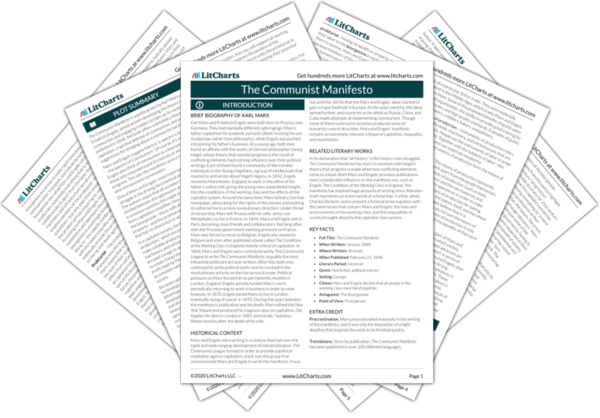At the end of The Communist Manifesto, Marx and Engels declare that the proletariat must free themselves of their “chains,” referring to the oppression of the proletariat by the bourgeoisie under the capitalist system. The use of the word “chains” illustrates that the dominance of the bourgeoisie over the proletariat represents a form of enslavement. This aligns with the authors’ argument that, as the bourgeoisie owns everything in society, the only resource the proletariat has is its labor power, which it must sell to the bourgeoisie in exchange for a wage. With no wealth of their own, members of the proletariat depend upon this wage for mere survival, putting their lives completely at the mercy of the bourgeoisie. Chains, then, represent the restriction that the class system imposes on the majority of society; because the proletariat has no property or wealth of its own, the only thing it has to lose in bringing about revolution is its enslavement. Finally, one of the actual uses of chains is to restrict movement—Marx and Engels are thus implying that the metaphorical chains of the proletariat prevent its own movement out of oppression. Communism, argue Marx and Engels, represents the proletariat’s opportunity to cast off its chains and “win” the world.
Chains Quotes in The Communist Manifesto
Modern industry has converted the little workshop of the patriarchal master into the great factory of the industrialist capitalist. Masses of laborers, crowded into the factory, are organized like soldiers. As privates of the individual army they are placed under the command of a perfect hierarchy of officers and sergeants. Not only are they slaves of the bourgeois class, and of the bourgeois State; they are daily and hourly enslaved by the machine, by the overlooker, and, above all, by the individual bourgeois manufacturer himself. The more openly this despotism proclaims gain to be its end and aim, the more petty, the more hateful and the more embittering it is.

Unlock explanations and citation info for this and every other The Communist Manifesto quote.
Plus so much more...
Get LitCharts A+Let the ruling classes tremble at a Communistic revolution. The proletarians have nothing to lose but their chains. They have a world to win.
WORKING MEN OF ALL COUNTRIES, UNITE!












